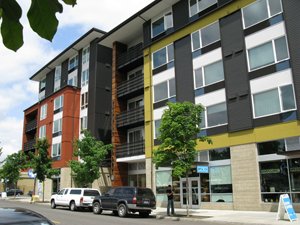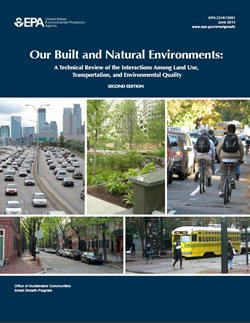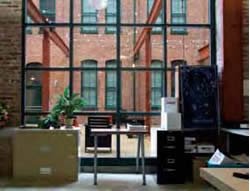Location and Green Building
- The Relationship between Location and Green Building
- Green Building Tools
- Resources and Reports
- Case Studies in Green Building
The Relationship between Location and Green Building

Green building is the practice of developing buildings that are environmentally responsible and resource-efficient throughout a building's life cycle. Beginning with site selection, planning, and design, through construction, maintenance, renovation, and demolition, buildings use energy, water, and raw materials. Buildings also generate carbon emissions through embodied carbon or waste generated in their operation.
During the initial site selection and planning phases, smart growth strategies, such as building compactly and putting a mix of uses close together, can reduce development impacts and enhance a community’s health and economy by using resources more efficiently.
Locating buildings on a site that has good transportation connections to the rest of the region can attract businesses that want easier access to customers and workers, and residents who want to be able to reach more jobs. Building in dense and transit-oriented places can also promote walkability and make it easier for people to drive less if they choose. This has additional benefits of reducing vehicle tailpipe emissions, which improves air quality and public health.
Compact development also creates less impervious surface per unit of development. Coupled with green building and green infrastructure techniques that capture and filter rainwater, it can reduce polluted stormwater runoff and protect water quality. In communities at greater risk from flooding or sea level rise, building compactly and using green infrastructure can help increase resilience to flooding and water rise.
A project's location is also informed by its social context. A location-efficient site is close to amenities such as employment centers, shops, restaurants, schools, and services, and connects the building to the community and larger region. Creating green buildings can help promote public health and equitable development.
Previously developed areas already served by infrastructure are efficient locations for development. Building in these areas reduces the need for new streets, utility lines, water pipes, and other infrastructure. It can also spur neighborhood revitalization by reusing and renovating existing structures. Historic buildings, vacant properties, or Brownfields can be transformed into a green development that supports the local economy and strengthens the community's character.
The tools and resources provided below can help your community learn about and begin to implement effective siting strategies and green building.
Green Building Tools
- Smart Location Database: Characterizes several built environment and regional accessibility variables for every census block group in the United States. This data can be used in scenario planning, travel demand studies, and more.
- Access to Jobs and Workers Via Transit Tool: Geospatial data resource and web mapping tool for comparing the accessibility of neighborhoods via public transit service.
- Green Building Tools for Tribes: Offers resources to help tribes develop, implement, and enforce culturally relevant green building codes, policies, and programs.
- Tribal Green Building Toolkit: Provides information on how tribes and other communities can prioritize and implement green building codes, policies, and practices. It includes a section on land use.
- Sustainable Design and Green Building Toolkit for Local Governments: Helps local governments identify and remove barriers to sustainable design and green building in existing codes and ordinances. The toolkit includes an assessment tool and resource guide, as well as a guide to developing a plan for implementing changes in a community's permitting process.
- Smart Growth Guidelines for Sustainable Design and Development: Helps users ensure that programs, plans, and proposed developments incorporate the elements needed at the location, site, and building levels to result in more environmentally sustainable, affordable housing.
Resources and Reports
- Green Building Trends and Sentiments (2023): US Green Building Council (USGBC) report summarizing current priorities in the green building field. This is an external report to provide additional information on recent green building topics.
- Green Building Overview and Issues (2021): Report from the Congressional Research Service providing an overview of green building and related issues.

- Our Built and Natural Environments (2013): Summarizes technical research on how development patterns affect human health and the environment and provides evidence that certain kinds of land use and transportation strategies can reduce the health and environmental impacts of development.
- Location Efficiency and Housing Type: Boiling It Down to BTUs (2011): Illustrates the relative impact of different development approaches: locating homes where less energy-intensive transportation options are available; constructing homes that use less energy because they share walls; and greening homes and cars through energy-efficient home construction techniques and fuel-efficient automobile technology. Its findings suggest that combining these approaches can achieve significant gains in household energy efficiency.
Case Studies in Green Building
From 2002 to 2015, EPA recognized communities that used innovative policies and strategies to strengthen their economies, provide housing and transportation choices, and protect the environment through the National Award for Smart Growth Achievement. From 2009 to 2011, the awards included a Smart Growth and Green Building category. Winners in that category were:

- Silver Gardens Apartments in Albuquerque, New Mexico: Recognized in 2011, this 66-unit affordable housing development is on a reclaimed brownfield site in downtown Albuquerque across the street from the city's primary transit hub. Silver Gardens is the Southwest's first LEED-Platinum affordable housing development and the first affordable housing project in the nation to sell carbon offsets.
- Miller's Court in Baltimore, Maryland: Recognized in 2010, Miller's Court integrates mixed-use redevelopment with preservation of a landmark historic building and sustainable design principles, such as location-efficient siting, sustainable materials, water and energy efficiency, natural lighting, indoor air quality, and innovative design.
- Tempe Transportation Center in Tempe, Arizona: Recognized in 2009, this multi-use green facility is a transportation hub and gathering spot for the community that replaced a 2.7-acre surface parking lot.
